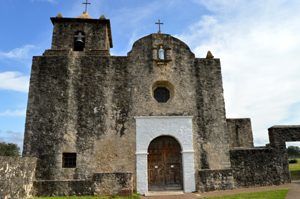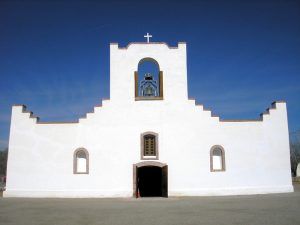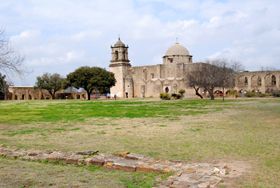Spanish Missions in Texas – Legends of America (original) (raw)
Mission San Jose, San Antonio, Texas by Kathy Alexander
Spanish Missions in Texas Map, courtesy National Park Service.
Mission Nuestra Señora de la Bahía del Espíritu Santo de Zúñiga, Goliad
Mission Nuestra Señora de la Purísima Concepción de Acuña, San Antonio Missions National Historical Park
Mission San Antonio de Valero, The Alamo, San Antonio
Mission San Francisco de la Espada, San Antonio Missions National Historical Park
Mission San José y San Miguel de Aguayo, San Antonio Missions National Historical Park
Mission San Juan Capistrano, San Antonio Missions National Historical Park
Mission Santa Cruz de San Sabá and Presidio San Luis de las Amarillas, Menard
Mission Nuestra Señora de la Limpia Concepción del Pueblo de Socorro, Socorro
Mission Corpus Christi de San Antonio de la Ysleta Sur, El Paso
~~
Our Lady of Loreto Chapel at the Presidio de la Bahia. Photo by Kathy Alexander.
The Spanish Missions in Texas were religious outposts established by Spanish priests and colonial authorities to spread the Catholic doctrine among Native Americans. With Church and State closely linked in Spain, the crown granted various religious orders of the Catholic Church permission to found mission communities to help the Spanish secure their claims to vast lands in North America.
Between 1632 and 1793, Spanish friars traveled north from Mexico into present-day Texas, where they built dozens of missions and presidios (military forts). In all, 26 missions were established and maintained in Texas with greatly varying results.
The goal was to establish autonomous Christian towns with communal property, labor, worship, political life, and social relations supervised by the missionaries. Seeking to make life within mission communities closely resemble that of Spanish villages and Spanish culture, the priests taught not only the Indians religion but also new life skills. They introduced European livestock, fruits, vegetables, and industry into the Texas area. Daily life followed a highly organized prayer, work, training, meals, and relaxation, punctuated by frequent religious holidays and celebrations.
The Nuestra Senora de la Concepcion del Socorro Church in Socorro, Texas by Kathy Alexander
To become Spanish citizens and “productive” inhabitants, the Indians were taught vocational skills, including farming, blacksmithing, masonry, carpentry, weaving, and more. The long-term plan was that the Native Americans would mature in Christianity and absorb Spanish culture and political and economic practices until they would no longer require special mission status. Then, as Spanish citizens, the communities could be incorporated into ordinary colonial society.
Although most of these missions fell short of their goal, several had relative success and grew into thriving settlements that are some of the state’s most important cities today. The famed Texas cattle industry was started by Spanish missionaries, who brought the first cattle from Mexico. The mission influence can still be seen across Texas in architecture, agriculture, and place names.
When the Spanish left the area, many of the missions were abandoned, fell into ruins, and the location of some were lost over time. However, several others are well preserved and restored and are open to visitors. Some even continue to operate as Catholic churches.
© Kathy Alexander/Legends of America, updated December 2022.
Mission San Jose, San Antonio, Texas by Kathy Alexander.
Also See:
A Day in the Life of a Spanish Missionary
Sources:
National Park Service
Texas Mission Guide
Texas State Historical Association
Wikipedia




